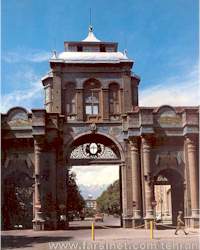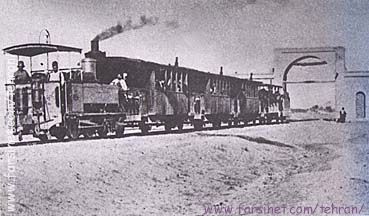History of Tehran
Tehran which today ranks among the large cities of the world, is historically a newcomer among Iran's ancient cities. The oldest record
mentioning Tehran, is the book of "tArikhe baghdAd" (Baghdad's History), written in 14 volumes by, Abu-Bakr Ahmad-ibn Ali-ibn
SAbet, also known as "khatibe baghdAdi".
Khatib, who died in the latter part of 11th century A.D., in his biography of Mohammed-ibn-HammAd, calls him Abi AbdollAh HAfeze
 TehrAniye RAzi. Before this, we do not find any mention of Tehran in any written document; after this some scant mentions of Tehran
are made in connection with its affluent agricultural products, specially its pomegranates. The first geographer who writes attentively
about Tehran, is ShahAb-od-din Abu AbdollAh (Yaghoote Hamavi), who lived around 13th century A.D. In his book Mo'jam-ol-BoldAn
he writes;
TehrAniye RAzi. Before this, we do not find any mention of Tehran in any written document; after this some scant mentions of Tehran
are made in connection with its affluent agricultural products, specially its pomegranates. The first geographer who writes attentively
about Tehran, is ShahAb-od-din Abu AbdollAh (Yaghoote Hamavi), who lived around 13th century A.D. In his book Mo'jam-ol-BoldAn
he writes;
"Tehran is one of the villages of Rey with rebellious inhabitants. They not only disregard their governors, but are in
constant clashes amongst themselves, to the extent that the inhabitants of its twelve quarters cannot visit one another."
 He adds that the TehrAnis lived in underground dwellings. His writings have been confirmed by the other geographers of the same period.
The onset of the destruction of Rey, first by sectarian schisms and fanaticism in the 12th century, followed by its annihilation in the
catastrophic sack by the Mongols in the year 1220 A.D., gave Tehran an opportunity for development and increased its population.
Finally in the second half of the 16th century, this green village attracted the attention of Shah TahmAsb I, the Safavid King, who ordered
that ramparts be constructed around it (1553 A.D.). From that time Tehran acquired the status of a city and grew systematically. The
length of these ramparts was about 6000 paces, and included 114 forts and four gates; these were:
He adds that the TehrAnis lived in underground dwellings. His writings have been confirmed by the other geographers of the same period.
The onset of the destruction of Rey, first by sectarian schisms and fanaticism in the 12th century, followed by its annihilation in the
catastrophic sack by the Mongols in the year 1220 A.D., gave Tehran an opportunity for development and increased its population.
Finally in the second half of the 16th century, this green village attracted the attention of Shah TahmAsb I, the Safavid King, who ordered
that ramparts be constructed around it (1553 A.D.). From that time Tehran acquired the status of a city and grew systematically. The
length of these ramparts was about 6000 paces, and included 114 forts and four gates; these were:

- The shah abdol azim gate ...darvAze shAb dol azim
- The doolAb gate ...darvAze doolAb
- The shemirAn gate ...darvAze shemroon
- The qazvin gate ...darvAze qazvin
Shah AbbAs who set out in the year 1589 A.D., to KhorAsAn to quell the attack of Abdol Mo'men KhAne Uzbak, stopped on his way in
Tehran, where he fell ill. This prevented him from reaching KhorAsAn in time and as a result Abdol Mo'men KhAn, looted Mashad,
killing a large number of its citizens. It has been mentioned by some sources that for this reason Shah AbbAs felt a distaste for Tehran.
Notwithstanding this, he ordered the planting of a grove of birch trees which later became the Arg of TehrAn. Pietro Della Valle, the
Italian traveler who was in Iran in the years 1617/1623 A.D. called Tehran "the birch city", and wrote that if two people held hands they
still could not encircle the trunks of these trees.
During the declining years of the Safavid rule a building was erected close to the birch grove on the orders of Shah Safi II, and Shah
SoltAn Hossein spent some time there at the end of his reign. After the fall of the Safavids, the AfghAns occupied TehrAn along with
other Iranian cities and chose to reside in the TehrAn Arg. After their defeat by NAder Shah, they looted TehrAn before they fled, killing
a large number of its citizens.
During the reign of NAder Shah little attention was paid to TehrAn. Later Karim KhAne Zand, in his war against Mohammad Hassan
Khane Qajar, chose TehrAn as his military headquarters and the gathering center of his soldiers. He was the first who thought of making
TehrAn his capital. The plan reached the stage where in the year 1758 A.D. offices and a harem were built within the Arg which was
surrounded by ramparts and moats. The plan to make TehrAn the capital, first thought of by the Zands, was carried out by Agha
Mohammad KhAne Qajar, who in the year 1785 A.D., proclaimed it his capital and bestowed on it the title of DAr ol KhelAfeh (the house
of the caliphate). During the reign of Fathali Shahe Qajar, TehrAn developed gradually, new buildings were erected and the population
increased.
Nonetheless, TehrAn was not a city fit to be the capital. Apart from the royal buildings, dwellings were bad and lacking most urban
necessities. Alleys were narrow, dusty and dark in the heat of summer, and full of mud-filled potholes in winter. All travelers and
political envoys described this and expressed their dissatisfaction. During the reigns of Mohammad Shahe Qajar and his son
NAser-Oddin Shah new developments and buildings slowly appeared and the first planned development was in the year 1867 A.D....
|




